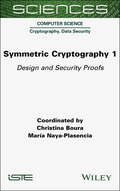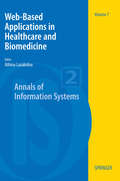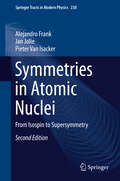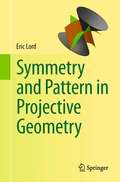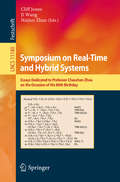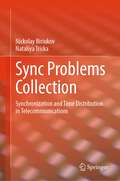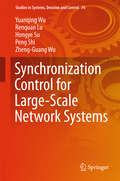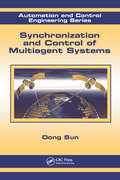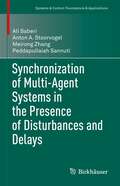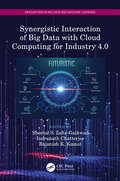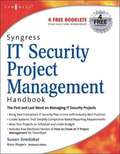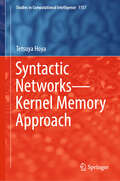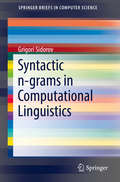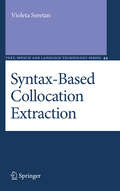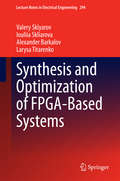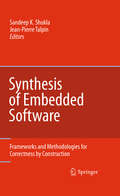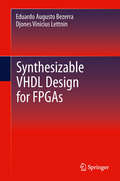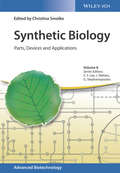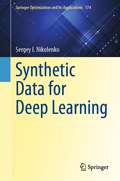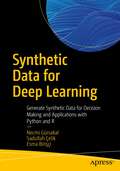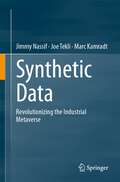- Table View
- List View
Symmetric Cryptography, Volume 1: Design and Security Proofs
by Christina Boura María Naya-PlasenciaSymmetric cryptology is one of the two main branches of cryptology. Its applications are essential and vital in the Information Age, due to the efficiency of its constructions. The scope of this book in two volumes is two-fold. First, it presents the most important ideas that have been used in the design of symmetric primitives, their inner components and their most relevant constructions. Second, it describes and provides insights on the most popular cryptanalysis and proof techniques for analyzing the security of the above algorithms. A selected number of future directions, such as post-quantum security or design of ciphers for modern needs and particular applications, are also discussed. We believe that the two volumes of this work will be of interest to researchers, to master’s and PhD students studying or working in the field of cryptography, as well as to all professionals working in the field of cybersecurity.
Symmetric Cryptography, Volume 2: Cryptanalysis and Future Directions
by Christina Boura María Naya-PlasenciaSymmetric cryptology is one of the two main branches of cryptology. Its applications are essential and vital in the Information Age, due to the efficiency of its constructions. The scope of this book in two volumes is two-fold. First, it presents the most important ideas that have been used in the design of symmetric primitives, their inner components and their most relevant constructions. Second, it describes and provides insights on the most popular cryptanalysis and proof techniques for analyzing the security of the above algorithms. A selected number of future directions, such as post-quantum security or design of ciphers for modern needs and particular applications, are also discussed. We believe that the two volumes of this work will be of interest to researchers, to master’s and PhD students studying or working in the field of cryptography, as well as to all professionals working in the field of cybersecurity.
Symmetries and Groups in Signal Processing: An Introduction (Signals and Communication Technology)
by Virendra P. SinhaSymmetries and Groups in Signal Processing: An Introduction deals with the subject of symmetry, and with its place and role in modern signal processing. In the sciences, symmetry considerations and related group theoretic techniques have had a place of central importance since the early twenties. In engineering, however, a matching recognition of their power is a relatively recent development. Despite that, the related literature, in the form of journal papers and research monographs, has grown enormously. A proper understanding of the concepts that have emerged in the process requires a mathematical background that goes beyond what is traditionally covered in an engineering undergraduate curriculum. Admittedly, there is a wide selection of excellent introductory textbooks on the subject of symmetry and group theory. But they are all primarily addressed to students of the sciences and mathematics, or to students of courses in mathematics. Addressed to students with an engineering background, this book is meant to help bridge the gap.
Symmetries in Atomic Nuclei
by Pieter Van Isacker Jan Jolie Alejandro FrankSymmetries in Atomic Nuclei aims to present an overview of recent applications of symmetry to the description of atomic nuclei. Special care is given to a pedagogical introduction of symmetry concepts using simple examples. After a historical overview of the applications of symmetry in nuclear physics, progress in the field during the last decade is reviewed. Special emphasis is put on the introduction of neutron-proton and boson-fermion degrees of freedom. Their combination leads to a supersymmetric description of pairs and quartets of nuclei. Both theoretical aspects and experimental signatures of dynamical (super)symmetries are carefully discussed. Case studies show how these symmetries are displayed by real atomic nuclei which have been studied experimentally using state-of-the art spectroscopy. This book focuses on nuclear structure physics and has been written by active investigators in the field, but its scope is wider and is intended for final-year or post-graduate students and researchers interested in understanding the power and beauty of symmetry methods in physics.
Symmetries in Atomic Nuclei: From Isospin to Supersymmetry (Springer Tracts in Modern Physics #230)
by Jan Jolie Alejandro Frank Pieter Van IsackerThe revised edition of this established work presents an extended overview of recent applications of symmetry to the description of atomic nuclei, including a pedagogical introduction to symmetry concepts using simple examples. Following a historical overview of the applications of symmetry in nuclear physics, attention turns to more recent progress in the field. Special emphasis is placed on the introduction of neutron-proton and boson-fermion degrees of freedom. Their combination leads to a supersymmetric description of pairs and quartets of nuclei. Expanded and updated throughout, the book now features separate chapters on the nuclear shell model and the interacting boson model, the former including discussion of recent results on seniority in a single-j shell. Both theoretical aspects and experimental signatures of dynamical (super)symmetries are carefully discussed. This book focuses on nuclear structure physics, but its broad scope makes it suitable for final-year or post-graduate students and researchers interested in understanding the power and beauty of symmetry methods in physics.Review of the 1st Edition:"The subject of this book, symmetries in physical systems, with particular focus on atomic nuclei, is of the utmost importance in modern physical science. In contrast to most treatments, frequently characterized by fearsome formalism, this book leads the reader step-by-step, in an easily understandable way, through this fascinating field...this book is remarkably accessible to both theorists and experimentalists. Indeed, I view it as essential reading for experimental nuclear structure physicists. This is one of the finest volumes on this subject I have ever encountered." Prof. R.F. Casten, Yale University
Symmetry and Pattern in Projective Geometry
by Eric LordSymmetry and Pattern in Projective Geometry is a self-contained study of projective geometry which compares and contrasts the analytic and axiomatic methods. The analytic approach is based on homogeneous coordinates, and brief introductions to Plücker coordinates and Grassmann coordinates are presented. This book looks carefully at linear, quadratic, cubic and quartic figures in two, three and higher dimensions. It deals at length with the extensions and consequences of basic theorems such as those of Pappus and Desargues. The emphasis throughout is on special configurations that have particularly interesting symmetry properties. The intricate and novel ideas of 'Donald' Coxeter, who is considered one of the great geometers of the twentieth century, are also discussed throughout the text. The book concludes with a useful analysis of finite geometries and a description of some of the remarkable configurations discovered by Coxeter. This book will be appreciated by mathematics students and those wishing to learn more about the subject of geometry. It makes accessible subjects and theorems which are often considered quite complicated and presents them in an easy-to-read and enjoyable manner.
Symposium on Real-Time and Hybrid Systems: Essays Dedicated to Professor Chaochen Zhou on the Occasion of His 80th Birthday (Lecture Notes in Computer Science #11180)
by Naijun Zhan Ji Wang Cliff JonesThis volume is published in honor of Professor Chaochen Zhou’s 80th birthday. The Festschrift contains 13 refereed papers by leading researchers who were among the participants of the celebratory conference in Changsha, China that took place in October 2017. The papers cover a broad spectrum of subjects related to Formal Methods for the development of computer systems. Topics include Probabilistic Programming, Concurrency, Quantum Computing, Domain Engineering, Real-time and Hybrid Systems, and Cloud Computing. Chaochen Zhou is internationally recognized for his own contributions and for the wide influence that he has had through his appointments in Oxford (UK) where he collaborated with Professor Tony Hoare, Lyngby (Denmark) where he worked with Professor Dines Bjørner, UNU-IIST (Macau) where he moved from being Principal Research Fellow to his appointed as Director of the Institute, as well as in Beijing. His book on the Duration Calculus (joint with Michael Hansen) made a seminal contribution to specifying and reasoning about real-time systems. Chaochen Zhou’s contributions have been marked by his election as a member of the Chinese Academy of Sciences.
Sync Problems Collection: Synchronization and Time Distribution in Telecommunications
by Nickolay Biriukov Nataliya TriskaThis textbook clarifies synchronization issues in telecommunications in an easy-to-follow way, focusing less on theory and more on practical aspects. The book is intended for a wide range of readers interested in the basic synchronization concepts in their wide application for development, maintenance, and conformity assessment of telecommunications equipment and networks. The authors show how, though synchronization in telecommunications has experienced rapid development, the foundational theory and the basic definitions, mathematical tools, and well-developed “classical” technologies have remained. The authors have studied the ITU-T, ETSI, IEEE standards, and extracted practical topics of synchronization. The collection of numerous training problems, practical examples, and case studies help the readers not only to find the answers to their current questions but also to get a common view of synchronization’s role in the modern telecommunications. The book is geared towards students of telecommunications but can also be useful for telecom engineers and for training/workshops for telecom engineers concerning synchronization topics.
Synchronization Control for Large-Scale Network Systems
by Peng Shi Hongye Su Zheng-Guang Wu Yuanqing Wu Renquan LuThis book provides recent advances in analysis and synthesis of Large-scale network systems (LSNSs) with sampled-data communication and non-identical nodes. In its first chapter of the book presents an introduction to Synchronization of LSNSs and Algebraic Graph Theory as well as an overview of recent developments of LSNSs with sampled data control or output regulation control. The main text of the book is organized into two main parts - Part I: LSNSs with sampled-data communication and Part II: LSNSs with non-identical nodes. This monograph provides up-to-date advances and some recent developments in the analysis and synthesis issues for LSNSs with sampled-data communication and non-identical nodes. It describes the constructions of the adaptive reference generators in the first stage and the robust regulators in the second stage. Examples are presented to show the effectiveness of the proposed design techniques.
Synchronization and Control of Multiagent Systems (Automation and Control Engineering)
by Dong SunMultiple intelligent agent systems are commonly used in research requiring complex behavior. Synchronization control provides an advantage in solving the problem of multi-agent coordination. This book focuses on the use of synchronization control to coordinate the group behavior of multiple agents. The author includes numerous real-world applicatio
Synchronization of Multi-Agent Systems in the Presence of Disturbances and Delays (Systems & Control: Foundations & Applications)
by Peddapullaiah Sannuti Ali Saberi Anton A. Stoorvogel Meirong ZhangThis monograph explores the synchronization of large-scale, multi-agent dynamical systems in the presence of disturbances, delays, and time-varying networks. Drawing upon their extensive work in this area, the authors provide a thorough treatment of agents with higher-order dynamics, different classes of models for agents, and the underlying networks representing the agents’ actions. The high technical level of their presentation and their rigorous mathematical approach make this a timely and valuable resource that will fill a gap in the existing literature. Divided into two sections, the first part of the book focuses on state synchronization of homogeneous multi-agent systems. The authors consider state synchronization by determining control strategies for both continuous- and discrete-time systems that achieve state synchronization under both full- and partial-state coupling. The chapters that follow examine multi-agent systems with both linear and nonlinear time-varying agents, input-delays for continuous- and discrete-time systems, and communication delays for continuous-time systems. The second part of the book is dedicated to regulated output synchronization of heterogeneous multi-agent systems with linear and nonlinear agents. Both sections of the book include performance considerations in H2- and H-infinity norms in the presence of external disturbances.Research on synchronization of multi-agent systems has been growing in popularity and is highly interdisciplinary, with applications to automobile systems, aerospace systems, multiple-satellite GPS and high-resolution satellite imagery, aircraft formations, highway traffic platooning, industrial process control with multiple processes, and more. Synchronization of Multi-Agent Systems in the Presence of Disturbances and Delays will therefore be of interest to upper-level graduate students, researchers, and engineers in industry working on interconnected dynamical systems.
Synergistic Interaction of Big Data with Cloud Computing for Industry 4.0 (Innovations in Big Data and Machine Learning)
by Rajanish K. Kamat Indranath Chatterjee Zalte-Gaikwad, Sheetal S.The idea behind this book is to simplify the journey of aspiring readers and researchers to understand the convergence of Big Data with the Cloud. This book presents the latest information on the adaptation and implementation of Big Data technologies in various cloud domains and Industry 4.0. Synergistic Interaction of Big Data with Cloud Computing for Industry 4.0 discusses how to develop adaptive, robust, scalable, and reliable applications that can be used in solutions for day-to-day problems. It focuses on the two frontiers — Big Data and Cloud Computing – and reviews the advantages and consequences of utilizing Cloud Computing to tackle Big Data issues within the manufacturing and production sector as part of Industry 4.0. The book unites some of the top Big Data experts throughout the world who contribute their knowledge and expertise on the different aspects, approaches, and concepts related to new technologies and novel findings. Based on the latest technologies, the book offers case studies and covers the major challenges, issues, and advances in Big Data and Cloud Computing for Industry 4.0. By exploring the basic and high-level concepts, this book serves as a guide for those in the industry, while also helping beginners and more advanced learners understand both basic and more complex aspects of the synergy between Big Data and Cloud Computing.
Syngress IT Security Project Management Handbook
by Susan SnedakerThe First and Last Word on Managing IT Security Projects As the late management guru Peter Drucker once said, "Plans are only good intentions unless they immediately degenerate into hard work." The intent of this book is not to lead you through long, arduous planning processes while hackers are stealing your network out from under you. The intent is to provide you with effective network security planning tools so that you can "degenerate into hard work" as quickly as possible to keep your network secure with the least amount of effort. Rather than losing sleep at night wondering who's wandering around your network in the dark, you can create a comprehensive security solution for your company that will meet your security needs today and will allow you to address new security requirements in the future. This book is designed to help you do exactly that. Analyze the Cost of Prevention Versus Remediation How to determine if preventing a security breach is less costly than fixing it once it occurs. Identify the Right Project Management Team Determine who will be affected and make certain they are on board from the start. Monitor IT Security Project Quality Many companies must comply with specific monitoring requirements to meet industry or governmental regulations. Create a Work Breakdown Structure (WBS) Be sure that your WBS tasks are at the same level by keeping the level of detail consistent. Create Reliable Documentation Your documentation should be well defined and completed in as near real time as possible. Implement Individual Security Analysis Programs (ISAPs) Testing requires an active "push" against security areas to ensure they don't collapse. Close the Issues Log, Change Requests, and Error Reports Addressing known issues in a reasonable manner and documenting those resolutions are important elements of reducing risk. Review Legal Standards Relevant to Your Project Failure to understand the legal implications may leave your company at substantial legal risk. Walk Through a Complete Plan Includes a step-by-step security project plan for a security assessment and audit project
Syntactic Networks—Kernel Memory Approach (Studies in Computational Intelligence #1157)
by Tetsuya HoyaThis book proposes a novel connectionist approach to a challenging topic of language modeling within the context of kernel memory and artificial mind system, both proposed previously by the author in the very first volume of the series, Artificial Mind System—Kernel Memory Approach: Studies in Computational Intelligence, Vol. 1. The present volume focuses on how syntactic structures of language are modeled in terms of the respective composite connectionist architectures, each embracing both the nonsymbolic and symbolic parts. These two parts are developed via inter-module processes within the artificial mind system and eventually integrated under a unified framework of kernel memory. The data representation by the networks embodied within the kernel memory principle is essentially local, unlike conventional artificial neural network models such as the pervasive multilayer perceptron-based neural networks. With this locality principle, kernel memory inherently bears many attractive features, such as topologically unconstrained network formation, straightforward network growing, shrinking, and reconfiguration, no requirement of arduous iterative parameter tuning, construction of transparent and hierarchical data structures, and multimodal and temporal data processing via the network representation. Exploiting these multifacet properties of kernel memory with interweaving the notion of inter-module processing within the artificial mind system provides coherent accounts for concept formation and how various linguistic phenomena, viz. word compoundings, morphologies, and multiword constructions, are modeled. The description is then extended to more intricate network models of context-dependent lexical network and syntactic-oriented processing, the latter being the central theme of the present study, and further to those representing a hybrid of nonverbal and verbal thinking, and semantic and pragmatic aspects of sentential meaning. The book is intended for general readers engaging in various areas of study in cognitive science, computer science, engineering, linguistics, philosophy, psycholinguistics, and psychology.
Syntactic n-grams in Computational Linguistics (SpringerBriefs in Computer Science)
by Grigori SidorovThis book is about a new approach in the field of computational linguistics related to the idea of constructing n-grams in non-linear manner, while the traditional approach consists in using the data from the surface structure of texts, i.e., the linear structure.In this book, we propose and systematize the concept of syntactic n-grams, which allows using syntactic information within the automatic text processing methods related to classification or clustering. It is a very interesting example of application of linguistic information in the automatic (computational) methods. Roughly speaking, the suggestion is to follow syntactic trees and construct n-grams based on paths in these trees. There are several types of non-linear n-grams; future work should determine, which types of n-grams are more useful in which natural language processing (NLP) tasks. This book is intended for specialists in the field of computational linguistics. However, we made an effort to explain in a clear manner how to use n-grams; we provide a large number of examples, and therefore we believe that the book is also useful for graduate students who already have some previous background in the field.
Syntax-Based Collocation Extraction
by Violeta SeretanSyntax-Based Collocation Extraction is the first book to offer a comprehensive, up-to-date review of the theoretical and applied work on word collocations. Backed by solid theoretical results, the computational experiments described based on data in four languages provide support for the book's basic argument for using syntax-driven extraction as an alternative to the current cooccurrence-based extraction techniques to efficiently extract collocational data. The work described in Syntax-Based Collocation Extraction focuses on using linguistic tools for corpus-based identification of collocations. It takes advantage of recent advances in parsing to propose a novel deep syntactic analytic collocation extraction that has applicability to a range of important core tasks in Computational Linguistics. The book is useful for anyone interested in computational analysis of texts, collocation phenomena, and multi-word expressions in general.
Synthesis and Optimization of FPGA-Based Systems
by Alexander Barkalov Larysa Titarenko Valery Sklyarov Iouliia SkliarovaThe book is composed of two parts. The first part introduces the concepts of the design of digital systems using contemporary field-programmable gate arrays (FPGAs). Various design techniques are discussed and illustrated by examples. The operation and effectiveness of these techniques is demonstrated through experiments that use relatively cheap prototyping boards that are widely available. The book begins with easily understandable introductory sections, continues with commonly used digital circuits, and then gradually extends to more advanced topics. The advanced topics include novel techniques where parallelism is applied extensively. These techniques involve not only core reconfigurable logical elements, but also use embedded blocks such as memories and digital signal processing slices and interactions with general-purpose and application-specific computing systems. Fully synthesizable specifications are provided in a hardware-description language (VHDL) and are ready to be tested and incorporated in engineering designs. A number of practical applications are discussed from areas such as data processing and vector-based computations (e. g. Hamming weight counters/comparators). The second part of the book covers the more theoretical aspects of finite state machine synthesis with the main objective of reducing basic FPGA resources, minimizing delays and achieving greater optimization of circuits and systems.
Synthesis of Embedded Software
by Jean-Pierre Talpin Sandeep Kumar ShuklaEmbedded software is ubiquitous today. There are millions of lines of embedded code in smart phones, and even more in systems responsible for automotive control, avionics control, weapons control and space missions. Some of these are safety-critical systems whose correctness, timely response, and reliability are of paramount importance. These requirement pose new challenges to system designers. This necessitates that a proper design science, based on "constructive correctness" be developed. Correct-by-construction design and synthesis of embedded software is done in a way so that post-development verification is minimized, and correct operation of embedded systems is maximized. This book presents the state of the art in the design of safety-critical, embedded software. It introduced readers to three major approaches to specification driven, embedded software synthesis/construction: synchronous programming based approaches, models of computation based approaches, and an approach based on concurrent programming with a co-design focused language. It is an invaluable reference for practitioners and researchers concerned with improving the product development life-cycle.
Synthesizable VHDL Design for FPGAs
by Eduardo Augusto Bezerra Djones Vinicius LettninThe methodology described in this book is the result of many years of research experience in the field of synthesizable VHDL design targeting FPGA based platforms. VHDL was first conceived as a documentation language for ASIC designs. Afterwards, the language was used for the behavioral simulation of ASICs, and also as a design input for synthesis tools. VHDL is a rich language, but just a small subset of it can be used to write synthesizable code, from which a physical circuit can be obtained. Usually VHDL books describe both, synthesis and simulation aspects of the language, but in this book the reader is conducted just through the features acceptable by synthesis tools. The book introduces the subjects in a gradual and concise way, providing just enough information for the reader to develop their synthesizable digital systems in VHDL. The examples in the book were planned targeting an FPGA platform widely used around the world.
Synthetic Aperture Radar (Springer Optimization and Its Applications #199)
by Panos M. Pardalos Arsenios Tsokas Maciej Rysz Kathleen M. Dipple Kaitlin L. FairThis carefully curated volume presents an in-depth, state-of-the-art discussion on many applications of Synthetic Aperture Radar (SAR). Integrating interdisciplinary sciences, the book features novel ideas, quantitative methods, and research results, promising to advance computational practices and technologies within the academic and industrial communities. SAR applications employ diverse and often complex computational methods rooted in machine learning, estimation, statistical learning, inversion models, and empirical models. Current and emerging applications of SAR data for earth observation, object detection and recognition, change detection, navigation, and interference mitigation are highlighted. Cutting edge methods, with particular emphasis on machine learning, are included. Contemporary deep learning models in object detection and recognition in SAR imagery with corresponding feature extraction and training schemes are considered. State-of-the-art neural network architectures in SAR-aided navigation are compared and discussed further. Advanced empirical and machine learning models in retrieving land and ocean information — wind, wave, soil conditions, among others, are also included.
Synthetic Biology and iGEM: An Omics Big-data Mining Perspective
by Kang Ning Yi ZhanThis book focuses on biological engineering techniques, multi-omics big-data integration, and data-mining techniques, as well as cutting-edge researches in principles and applications of several synthetic biology applications. Synthetic biology is a new research area, while it has been rooted from the long-established area including biological engineering, metabolite engineering, and systems biology. This book will discuss the following aspects: (1) introduction to synthetic biology and iGEM, especially focusing on the systematic design, rational engineering, and sustainability of design in the omics ages; (2) synthetic biology–related multi-omics data integration and data mining techniques; (3) the technical issues, development issues, and safety issues of synthetic biology; (4) data resources, web services, and visualizations for synthetic biology; and (5) advancement in concrete research on synthetic biology, with several case studies shown. Devised as a book on synthetic biology research and education in the omics age, this book has put focuses on systematic design, rational engineering, and sustainability of design for synthetic biology, which will explain in detail and with supportive examples the “What,” “Why,” and “How” of the topic. It is an attempt to bridge the gap between synthetic biology’s research and education side, for best practice of synthetic biology and in-depth insights for the related questions.
Synthetic Biology: Parts, Devices and Applications (Advanced Biotechnology)
by Jens Nielsen Gregory Stephanopoulos Sang Yup Lee Christina Smolkeneed new text The inaugural volume of this new reference work in biotechnology is the most comprehensive of its kind on the market, covering everything from DNA synthesis to RNA interference and biosensors. Edited by the renowned scientists Sven Panke of the Swiss Federal Institute of Technology and Christina Smolke from Stanford University.
Synthetic Data for Deep Learning (Springer Optimization and Its Applications #174)
by Sergey I. NikolenkoThis is the first book on synthetic data for deep learning, and its breadth of coverage may render this book as the default reference on synthetic data for years to come. The book can also serve as an introduction to several other important subfields of machine learning that are seldom touched upon in other books. Machine learning as a discipline would not be possible without the inner workings of optimization at hand. The book includes the necessary sinews of optimization though the crux of the discussion centers on the increasingly popular tool for training deep learning models, namely synthetic data. It is expected that the field of synthetic data will undergo exponential growth in the near future. This book serves as a comprehensive survey of the field. In the simplest case, synthetic data refers to computer-generated graphics used to train computer vision models. There are many more facets of synthetic data to consider. In the section on basic computer vision, the book discusses fundamental computer vision problems, both low-level (e.g., optical flow estimation) and high-level (e.g., object detection and semantic segmentation), synthetic environments and datasets for outdoor and urban scenes (autonomous driving), indoor scenes (indoor navigation), aerial navigation, and simulation environments for robotics. Additionally, it touches upon applications of synthetic data outside computer vision (in neural programming, bioinformatics, NLP, and more). It also surveys the work on improving synthetic data development and alternative ways to produce it such as GANs. The book introduces and reviews several different approaches to synthetic data in various domains of machine learning, most notably the following fields: domain adaptation for making synthetic data more realistic and/or adapting the models to be trained on synthetic data and differential privacy for generating synthetic data with privacy guarantees. This discussion is accompanied by an introduction into generative adversarial networks (GAN) and an introduction to differential privacy.
Synthetic Data for Deep Learning: Generate Synthetic Data for Decision Making and Applications with Python and R
by Necmi Gürsakal Sadullah Çelik Esma BirişçiData is the indispensable fuel that drives the decision making of everything from governments, to major corporations, to sports teams. Its value is almost beyond measure. But what if that data is either unavailable or problematic to access? That’s where synthetic data comes in. This book will show you how to generate synthetic data and use it to maximum effect. Synthetic Data for Deep Learning begins by tracing the need for and development of synthetic data before delving into the role it plays in machine learning and computer vision. You’ll gain insight into how synthetic data can be used to study the benefits of autonomous driving systems and to make accurate predictions about real-world data. You’ll work through practical examples of synthetic data generation using Python and R, placing its purpose and methods in a real-world context. Generative Adversarial Networks (GANs) are also covered in detail, explaining how they work and their potential applications. After completing this book, you’ll have the knowledge necessary to generate and use synthetic data to enhance your corporate, scientific, or governmental decision making.What You Will LearnCreate synthetic tabular data with R and PythonUnderstand how synthetic data is important for artificial neural networksMaster the benefits and challenges of synthetic dataUnderstand concepts such as domain randomization and domain adaptation related to synthetic data generationWho This Book Is ForThose who want to learn about synthetic data and its applications, especially professionals working in the field of machine learning and computer vision. This book will also be useful for graduate and doctoral students interested in this subject.
Synthetic Data: Revolutionizing the Industrial Metaverse
by Joe Tekli Jimmy Nassif Marc KamradtThe book concentrates on the impact of digitalization and digital transformation technologies on the Industry 4.0 and smart factories, how the factory of tomorrow can be designed, built, and run virtually as a digital twin likeness of its real-world counterpart, before the physical structure is actually erected.It highlights the main digitalization technologies that have stimulated the Industry 4.0, how these technologies work and integrate with each other, and how they are shaping the industry of the future.It examines how multimedia data and digital images in particular are being leveraged to create fully virtualized worlds in the form of digital twin factories and fully virtualized industrial assets. It uses BMW Group’s latest SORDI dataset (Synthetic Object Recognition Dataset for Industry), i.e., the largest industrial images dataset to-date and its applications at BMW Group and Idealworks, as one of the main explanatory scenarios throughout the book.It discusses the need of synthetic data to train advanced deep learning computer vision models, and how such datasets will help create the “robot gym” of the future: training robots on synthetic images to prepare them to function in the real world.
